Disclosure: Meeple Mountain received a free copy of this product in exchange for an honest, unbiased review. This review is not intended to be an endorsement.
Building and maintaining a freshwater aquarium can be a very rewarding endeavour. There’s no denying the beauty of the fish thriving under your care just as there’s no denying the serene satisfaction that comes along with a job well done. But there’s more to bringing a freshwater tank to fruition than just buying a tank, filling it up with water, and tossing some fish into it.
A lot more.
If you go into the hobby without already having a good idea of what you’re doing, it’s going to cost you a lot of extra time and money to finally get it right. And it’s going to cost your poor fish their lives. In an effort to educate would-be freshwater aquarium owners and help them (and their fish) avoid this fate, the people at Kaplan Crypto have designed a game to assist. In Freshwater Tank you will be racing your opponents to be the first to successfully put together an aquarium of 10 fish that are able to live with each other harmoniously.
Using a roll and move mechanism, players will roll a die to advance their pawn around the board collecting fish and dealing with various events along the way. Each player begins the game with a single tank. This is important because when you acquire a new fish, you’ve got to decide whether to discard it or add it to your tank and discard any fish you might already have that are incompatible with it. Opportunities to acquire a second tank may arise, but they are few and far between.
Only through thoughtful tank management and some luck will you be able to put together a tank with 10 fish before your opponents and emerge as the victor.
How It’s Played
The game is setup like this:
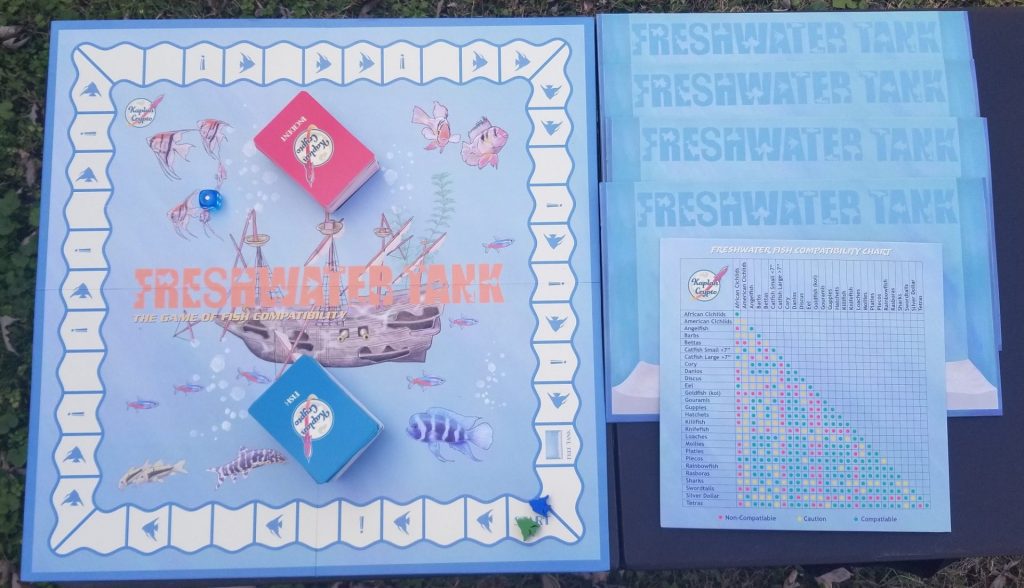
The board is laid out between the players with the red Incident cards and blue Fish cards shuffled into separate decks and placed face down on their respective locations on the game board. Each player is given an empty Fish Tank board and then an extra 2 are set aside. Any remainders are returned to the box. Then the players roll the die to determine who goes first.
On their turn, a player will roll the die and advance their pawn along the track a number of spaces equal to the number of pips on the die. If the player lands on a ‘!’ space, they will draw an Incident card and then do whatever the card says. Usually the card has the player move forward or back a few spaces, but sometimes it’s something else like winning a fish in a contest and having to decide whether to add it to their tank or having them add a piranha to their tank that eats all of their other fish.
If the player lands on a fish space, then they draw a card from the Fish deck and have to decide whether to add the fish to their tank. There are a couple of things to consider when doing this. Firstly, each fish has a certain temperament shown by the colored background on the card–peaceful, semi-aggressive, aggressive, or very aggressive represented by light blue, orange, red, or purple respectively. Secondly, each fish has very specific degrees of compatibility with other fish–compatible, caution, or non-compatible.
To help parse this information, there are two copies of a Compatibility chart included with the game. The chart is broken down into rows and columns with each fish appearing on its own row and its own column. The intersection of the line drawn from two fish will show their compatibility.

For example: need to know how compatible an eel is with a goldfish? Find the eel in the row or column and find the goldfish in the other and then find the point where the two intersect. (They are non-compatible in case you’re wondering.)
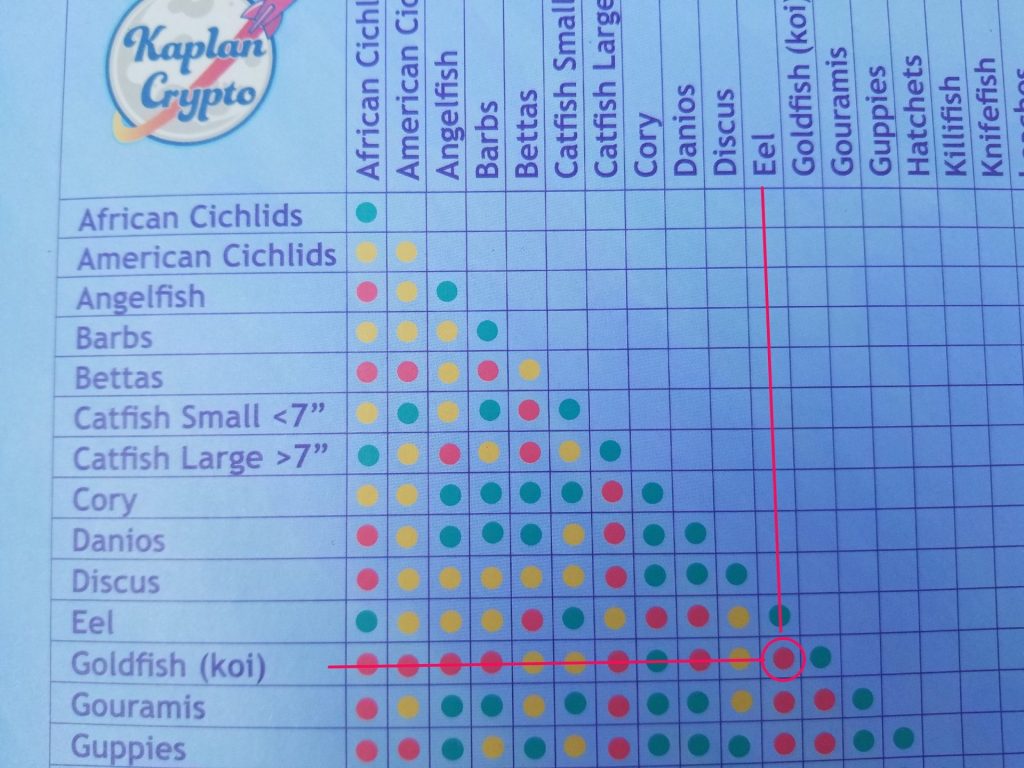
There’s also a long list of if-then statements in the rule book to guide you along. Using the example above, let’s see how you’d handle this scenario.
The rule book states: “If one fish is peaceful and the other is semi-aggressive and both are incompatible, they cannot be kept”. The Ranchu Goldfish is a) peaceful and b) a goldfish and the Tire Track Eel is a) semi-aggressive and b) an eel. Looking at the Compatibility chart, we see that eels and goldfish are non-compatible. We also know what their temperaments are. So combining the if-then statement with everything else we know about these two types of fish, we know that they cannot be kept together in the same tank.
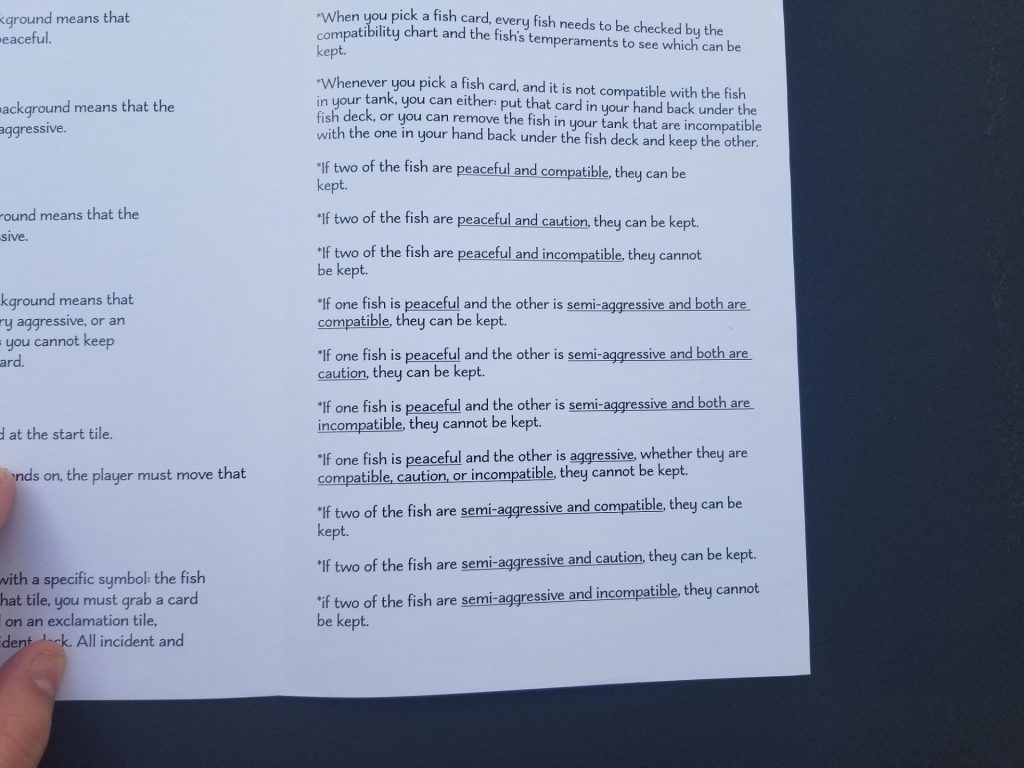
Of course, if you had multiple fish of different types in your aquarium already, then you’re going to need to perform this temperament/compatibility check for each fish. The game has several different game modes that limit the number of “Caution fish” that can co-exist in a tank together. If you’re using one of those game modes and already have fish in the tank that barely tolerate one another, then the temperament/compatibility check may need to be reassessed for those fish as well when considering whether to add the fish you just picked up so that you don’t go over the Caution fish limit
And that’s it. Players continue taking turns rolling dice and moving around the board until someone manages to add a 10th fish to their tank at which point the game ends and that person wins.
Thoughts
When designing an educational board game, there’s a fine line you must walk between creating something that’s fun and engaging and something that’s informative and thought-provoking. It’s a task that is not easily accomplished, but it is doable. Just take a look at games like Subatomic or Genotype and you’ll see what I mean. These are games that not only challenge you as a gamer, but also tickle your grey cells while doing it.
While Freshwater Tank succeeds in its mission to educate, it pretty much fails as a game. Such is the nature of most games that use the roll and move mechanic. By and large, these games almost always come down to sheer, dumb luck. Some games like Rallyman GT or Merlin overcome this shortcoming somewhat by presenting you with multiple dice and forcing you to have to decide how to distribute them. But Freshwater Tank doesn’t do any of this. It has a very Monopoly feel to it minus the ‘actually doing things on all of your turns’ aspect (which is probably the only time you’ll ever hear me touting something about Monopoly as a positive).
The game suffers from some other issues as well.
For instance, as I mentioned during the gameplay portion of this review, every time you add a fish, you have to check the Compatibility chart and measure the new fish against your old ones to see if the new fish is compatible with the old ones. If the old ones were just barely compatible with each other, then you have to reassess your old situation before you can assess the new fish. It’s just a lot of unnecessary convolution that doesn’t really add anything of value to the game. And I didn’t mention this earlier, but the print on this chart is tiny, making it very hard to read. It’s bad enough having to navigate the chart for even a single pairing, but having to do this multiple times? Not fun at all.
Also, the rule book (and I am being generous with that term) leaves a lot to be desired. There are a lot of grey areas that the rules just don’t cover or provide clear resolution for. Consider the question of compatibility in the following example, for instance. A large catfish is barely compatible with an eel. Does that count as two Caution fish (one catfish versus one eel) or a single Caution fish (a single point of conflict)? If it counts as a single and I add a second large catfish, have I added a second Caution fish (one specific catfish vs. one specific eel, one specific catfish vs. one specific eel)? Or is it just a single Caution fish still (catfish group vs. eel group)? This question becomes even more compounded if I add a second eel to this mix.
Another example: in one game that we played, my first roll of the game was a 2 which landed me on an Incident space that told me to move backwards 6 spaces. This moved me behind the start line onto the space that you’d normally have to go all the way around the track to land on, which grants you an extra fish tank. Are you allowed to move backwards beyond the Start space at the beginning of the game? And later on, after having gone around the board normally, I landed on the space a second time. Am I allowed to own BOTH of the extra fish tanks or am I only allowed to own a single one? Who knows? The rule book doesn’t provide any kind of answer to these questions.
And let’s consider the piranha Incident card from earlier. When drawing a Fish card, the game always lets you decide whether or not to add the fish to your tank. Why couldn’t you just choose to NOT add the piranha? Are you allowed to ignore an Incident card or are you forced to perform the action on the card? If you are allowed to ignore an Incident card, then why even have a card like the piranha card in the game to begin with? There are zero scenarios where you’d want to have everything in your tank eaten by another fish, so you would always ignore it. This would imply that Incident cards cannot be ignored. But it is never explicitly stated that this is the case.
When I was initially offered this game for review, I had a feeling that this was how things were going to go. I was hoping that I’d be pleasantly surprised, but that just wasn’t in the cards. But maybe I’m not the target audience. Maybe the intent here was more to educate than provide an amazing game experience.
To test that theory, I sat down for a game with my best friend (you can see him standing next to me in the photo from my article I wrote for Tabletop Day several years ago) who is an aquarium aficionado. He has run the gamut from a tiny freshwater tank with one or two fish to giant sprawling salt water tanks teeming with coral and all manner of aquatic life. While he also wasn’t a fan of the game, he did inform me that the information presented in the game is very accurate, although it does gloss over some important details like fish size to tank size ratios. Freshwater Tank skims over a lot of that stuff and, in both of our opinions, it does itself a disservice.
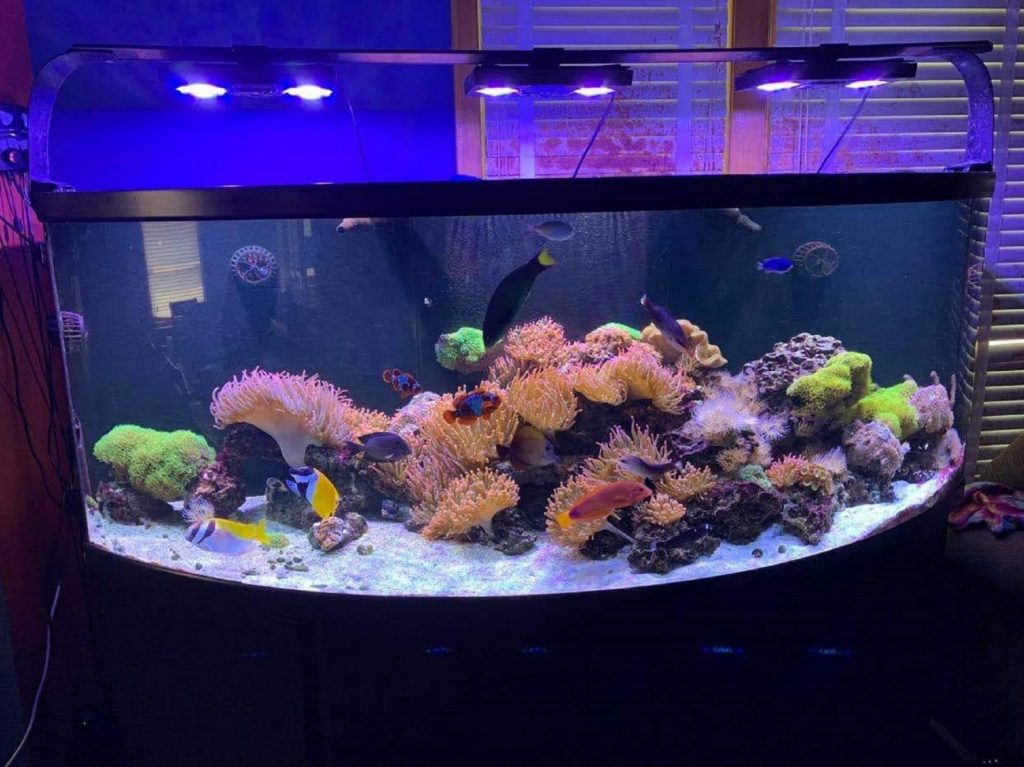
There is a skeleton of what could be a really good game here. Making different fish be worth differing victory point values or giving the players hidden objective cards (an all-cichlid tank, for instance) or some mixture of these would liven things up a bit. Forcing players to have to upgrade their tanks as they acquired more diverse fish would more realistically simulate the trials and tribulations that aquarium neophytes experience. Those are just a few simple suggestions that could vastly improve this game.
I had a phenomenal time playing the game, however. There’s no beating playing a board game (something I am passionate about) with my best friend who’s passionate about that aquarium life. As each card was flipped up, he had something interesting to say about it. As each Incident card that featured an actual incident (“Move forward 3 spaces” is NOT an incident!) flipped up, I could see him nodding his head in recognition or chuckling about how anyone would be stupid enough to throw a piranha into a tank full of gold fish.
The good time, however, had very little to do with the game itself. It’s just a testament that sometimes even the jankiest of games can still result in a good experience if you’re with the right people. When asked how he felt about the game, my friend put it pretty succinctly: “There is not enough meat on the bone for me. I do like the concept though.” I can’t say I disagree. I wish Kaplan Crypto the best of success with this game, but I won’t be recommending it to anyone anytime soon.


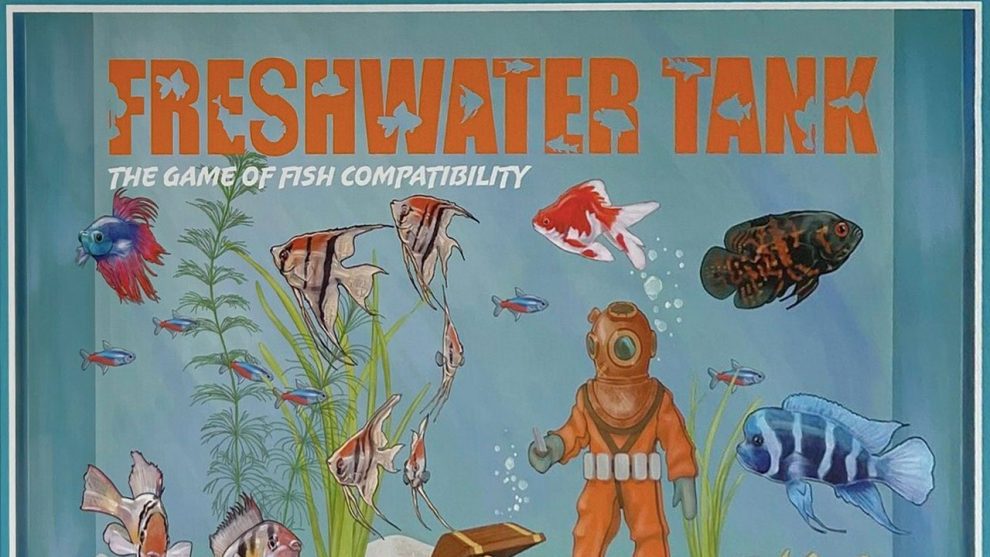

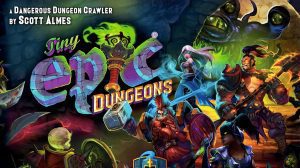






Add Comment